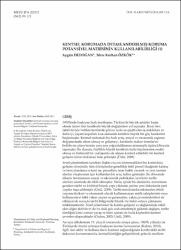| dc.contributor.author | Erdoğan, Aygün | |
| dc.contributor.author | Ozkok, Mete Korhan | |
| dc.date.accessioned | 2021-12-12T17:02:37Z | |
| dc.date.available | 2021-12-12T17:02:37Z | |
| dc.date.issued | 2017 | |
| dc.identifier.issn | 0258-5316 | |
| dc.identifier.uri | https://doi.org/10.4305/METU.JFA.2017.2.6 | |
| dc.identifier.uri | https://hdl.handle.net/20.500.11857/3501 | |
| dc.description.abstract | The spatial and functional changes that occurred in Turkey's historical city centers, especially after the 1950s, led to the rise of many common physical, social, and economic problems. The shortcomings in the related studies and the development of a distinct planning language to resolve these problems result in practical limitations. Today, in general, conservation efforts, which are carried out in historic commercial centers to renovate the physical structure, fail in the economic and social fabric to a large extent. This study identifies such problems being faced in historic city centers through comprehensive analysis, and puts forward holistic solutions regarding these physical, economic, and social issues. To this end, Nahoum Cohen's (1999) conservation potential matrix method, which is built on his field studies in various historic cities, is improved by integrating a set of sub-components (criteria) and their respective measures. This detailed conservation potential matrix was tested on the case of Kemeralti Historic Commercial Zone in the city of Trabzon. The possibility to use and the prospective solutions that the detailed matrix can provide were searched in identifying sub-zones at different levels of conservation in the case area by thorough analyses. In improving Cohen's model while maintaining its essence, particular attention is paid to utilize easy-to-access data on the historic zones of cities in Turkey. Through this newly generated approach; holistic policy proposals, interventions and their priorities were elaborately defined for each sub-zone. Finally, inferences were made on the prospective usability of this detailed model of conservation potential matrix. | en_US |
| dc.language.iso | tur | en_US |
| dc.publisher | Middle East Technical Univ | en_US |
| dc.relation.ispartof | Metu Journal of the Faculty of Architecture | en_US |
| dc.identifier.doi | 10.4305/METU.JFA.2017.2.6 | |
| dc.rights | info:eu-repo/semantics/openAccess | en_US |
| dc.subject | Urban conservation | en_US |
| dc.subject | conservation potential matrix | en_US |
| dc.subject | historic city center | en_US |
| dc.subject | historic commercial zone | en_US |
| dc.subject | Trabzon-Kemeralti | en_US |
| dc.title | KENTSEL KORUMADA DETAYLANDIRILMIŞ KORUMA
POTANSİYEL MATRİSİNİN KULLANILABİLİRLİĞİ (1) | en_US |
| dc.type | article | |
| dc.authorid | Erdogan, Aygun/0000-0002-5178-6555 | |
| dc.authorid | OZKOK, Mete Korhan/0000-0001-8734-3644 | |
| dc.department | Fakülteler, Mimarlık Fakültesi, Şehir ve Bölge Planlama Bölümü | |
| dc.identifier.volume | 34 | en_US |
| dc.identifier.startpage | 93 | en_US |
| dc.identifier.issue | 2 | en_US |
| dc.identifier.endpage | 123 | en_US |
| dc.relation.publicationcategory | Makale - Uluslararası Hakemli Dergi - Kurum Öğretim Elemanı | en_US |
| dc.authorscopusid | 57191279875 | |
| dc.authorscopusid | 57200188312 | |
| dc.identifier.wos | WOS:000423288300007 | en_US |
| dc.identifier.scopus | 2-s2.0-85040123408 | en_US |
| dc.authorwosid | Erdogan, Aygun/AAK-4861-2020 | |
| dc.authorwosid | OZKOK, Mete Korhan/ABE-9167-2021 | |



















